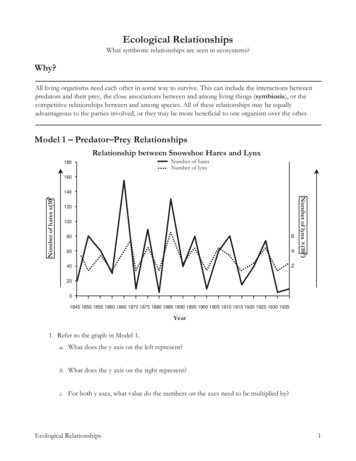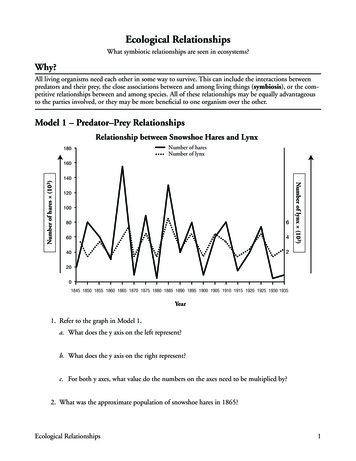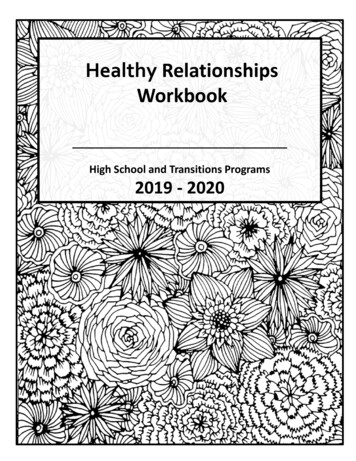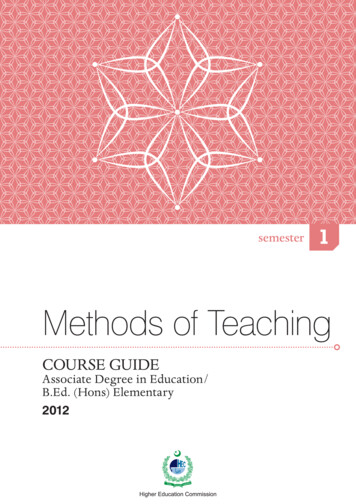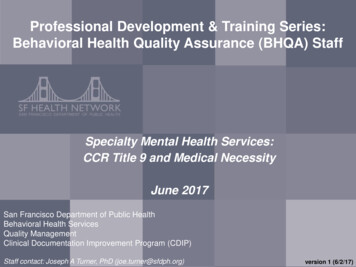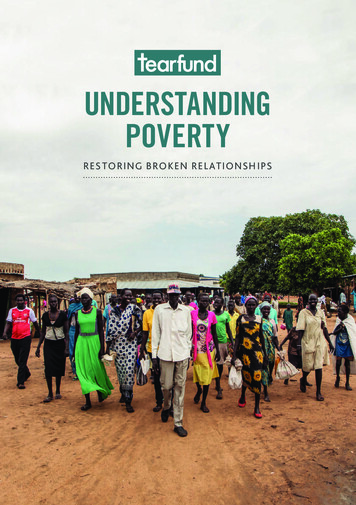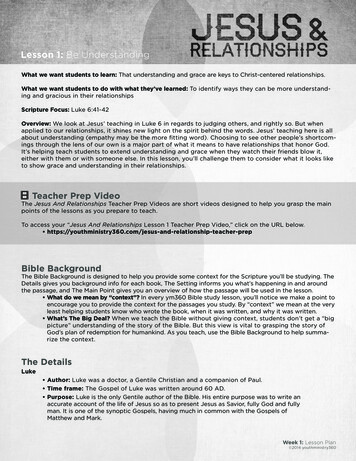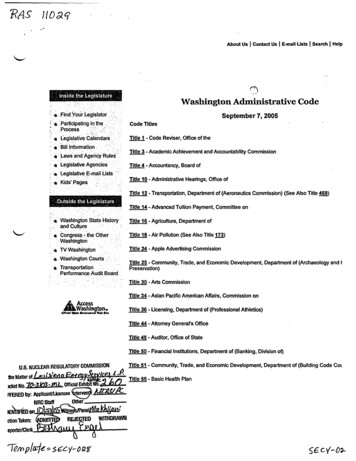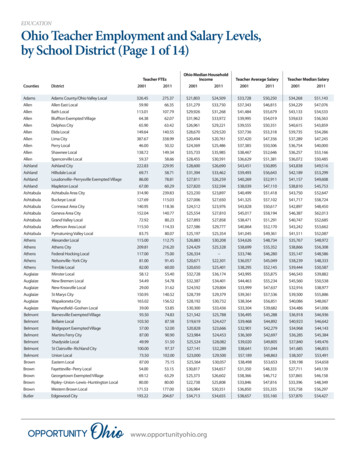
Transcription
Unit Title: Understanding RelationshipsClass: Relationships Across theLifespan/ParentingGrade: 10th-12th gradersTeacher: Ms. FuerstDuration: 3-4 weeksSummary of unit:This first unit is to help students understand the different types of relationships and the difference between healthy andunhealthy relationships.Stage 1- Desired ResultsEssential Questions:Standards:RAL 1.1 Demonstrate communication skills thatcontribute to positive relationships.What is the difference between a healthy and unhealthy relationship?What are different types of relationships?RAL 1.2 Identify effective conflict prevention andmanagement strategies.RAL 1.3 Investigate the diversity of family rolesand structures.What are ways to build and maintain a strong relationship?What are characteristics of a unhealthy relationship?What are reasons and ways to end a relationship?RAL 1.4 Recognize the influence that internal andexternal conditions have on interpersonalrelationships.Vocab:Students will understand:Students will know: The following vocabularyterms:What is the difference between a healthy and unhealthy relationshipWhat a stereotype is and how to avoid themRelationship, expectation, tolerance,discrimination, stereotype, isolated, inadequate,dependent, vulnerableHow to have relationships with all types of peopleStage 2- Assessment Evidence
Performance Tasks:Unit Pre-Assessment:Journals, quizzes, worksheets, tests/final project-introduction questions-pre-assessment quizUnit Post-Assessment:-unit testStage 3- Learning PlanLearning Activities: (How is the content taught?) procedures/topics-reading and note taking-class activities-hands-on activities-quizzes and testsLesson DescriptionsLesson 1: Successful relationshipsLesson 2: Understanding YourselfLesson 3: Self-ConceptLesson 4: Needs vs WantsLesson 5: Dealing with EmotionsLesson 6: Unhealthy RelationshipsLesson 7: StereotypingLesson 8: Healthy vs Unhealthy Relationships
Unit Title: Family RelationshipsClass: Relationships Across theLifespan/ParentingGrade: 10th-12th gradersTeacher: Ms. FuerstDuration: 3-4 weeksSummary of unit:This unit is about family relationships. Families provide the care and attention needed to promote each member’sdevelopment. They will usually adapt to changing situations and priorities. Some of these changes are a result of societaltrends. Others are challenges that arise due to changes in life circumstances or crises that cause severe stress.Standards:Stage 1- Desired ResultsEssential Questions:RAL 4 Evaluate the impact of relationshipsbetween family and workplace.What are the primary functions of family?What are the common family structures?What is the family life cycle?What are ways to strengthen families?What are some family challenges that can turn into crises?Vocab:Students will understand:Students will know: The following vocabularyterms:Functions of the familyFamily StructuresNuture, socialization, family life cycle,intergenerational, support system, crisis, custody,grief, substance abuse, alcoholism, abuse, neglectFamily Life CycleWays to strengthen familiesExamples of family crisesStage 2- Assessment EvidencePerformance Tasks:Unit Pre-Assessment:
Journals, quizzes, worksheets, tests/final project-introduction questionsUnit Post-Assessment:-unit testStage 3- Learning PlanLearning Activities: (How is the content taught?) procedures/topics-reading and note taking-class activities-hands-on activities-quizzes and testsLesson DescriptionsLesson 1: Defining FamiliesLesson 2: Family FunctionsLesson 3: Family StructuresLesson 4: Family Life CycleLesson 5: Family Crises
Unit Title: Dating/Marriage RelationshipsClass: Relationships Across theLifespan/ParentingGrade: 10th-12th gradersTeacher: Ms. FuerstDuration: 3-4 weeksSummary of unit:This unit is about teenage relationships and talking about marriage as well. Whether teens date in groups or as couples, theyneed to set boundaries, and express emotions. Eventually, couples may plan on getting married. Strong marriages developskills in communication, shared responsibility, and conflict resolution. However, marriages can fail for a variety of reasons,and some people may choose to remain single.Standards:Stage 1- Desired ResultsEssential Questions:RAL 3 Analyze healthy relationships with adults ofall ages.What are the reasons for dating different people before getting married?What are the guidelines for responsible dating relationships?RAL 1 Analyze functions and dynamics ofinterpersonal relationships.What are the emotional challenges that may arise in a relationship?How do you know whether a dating relationship has the potential forcommitment?What are the factors that contribute to marital success and failure?What are the reasons for choosing to remain single?Vocab:Students will understand:Students will know: The following vocabularyterms:Explain are the reasons for dating different people before gettingmarried.Infatuation, jealousy, boundaries, compatible,commitment, engagement period, monogamy,annulment, prohibitDetermine what are the guidelines for responsible dating relationships?Identify the emotional challenges that may arise in a relationship.
Determine whether a dating relationship has the potential forcommitment.Summarize the factors that contribute to marital success and failure.List reasons for choosing to remain single.Stage 2- Assessment EvidencePerformance Tasks:Unit Pre-Assessment:Journals, quizzes, worksheets, tests/final project-introduction questionsUnit Post-Assessment:-unit testStage 3- Learning PlanLearning Activities: (How is the content taught?) procedures/topics-reading and note taking-class activities-hands-on activities-quizzes and testsLesson DescriptionsLesson 1: Responsible DatingLesson 2: Healthy vs Unhealthy dating relationshipsLesson 3: Decisions about MarriageLesson 4: Setting emotional and physical bounariesLesson 5: Remaining Single
Unit Title: Workplace RelationshipsClass: Relationships Across theLifespan/ParentingGrade: 10th-12th gradersTeacher: Ms. FuerstDuration: 2-3 weeksSummary of unit:This unit is about workplace relationships. Workplace relationships differ from other types of relationships. Employees need toestablish a positive working relationship with coworkers and supervisors. Problems in a working relationship are often theresult of conflict, stereotyping, rivalry, or harassment. Sometimes employees struggle with separating work from their personallives.Standards:RAL 4 Evaluate the impact of relationshipsbetween family and workplace.Stage 1- Desired ResultsEssential Questions:How do workplace relationships differ from other types of relationships?What are strategies for getting along with coworkers?What are guidelines for getting along with supervisors?What are common workplace relationship problems and how to addressthem?What are the reasons for keeping your personal life out of yourworkplace?Vocab:Students will understand:Students will know: The following vocabularyterms:Explain how workplace relationships differ from other types ofrelationships.Etiquette, supervisor, contribute, objective, thirdparty, rivalry, resentment, neutral, alternateIdentify strategies for getting along with coworkers.List guidelines for getting along with supervisors.
Name common workplace relationship problems and how to addressthem.Summarize the reasons for keeping your personal life out of yourworkplace.Stage 2- Assessment EvidencePerformance Tasks:Unit Pre-Assessment:Journals, quizzes, worksheets, tests/final project-introduction questionsUnit Post-Assessment:-unit testStage 3- Learning PlanLearning Activities: (How is the content taught?) procedures/topics-reading and note taking-class activities-hands-on activities-quizzes and testsLesson DescriptionsLesson 1: The workplace environmentLesson 2: How to communicate in the workplaceLesson 3: Workplace EtiquetteLesson 4: Talking to your SupervisorLesson 5: Workplace Relationship ChallengesLesson 6: Workplace Harassment
Unit Title: Relationships with childrenClass: Relationships Across theLifespan/ParentingGrade: 10th-12th gradersTeacher: Ms. FuerstDuration: 3-4 weeksSummary of unit:This unit is about relationships with children and parenting. Students will learn about parenting practices and what to expect inthe future if they are parents. We will discuss parenting styles, teen pregnancy, child abuse, and the health and safety ofchildren. This unit covers a wide variety of material.Stage 1- Desired ResultsEssential Questions:Standards:RAL 2 Analyze healthy relationships with children.What does a healthy relationship with children look like?What are the different parenting styles?What does it mean to be a responsible parent?What happens when you become a teen parent?What is child abuse?What are different safety precautions for children?Vocab:Students will understand:Students will know: The following vocabularyterms:How to have a healthy relationship with your children.What the 4 basic parenting styles are.Parenting styles, permissive style, authoritarian,authoritative, neglect, child abuse, verbal abuse,physical abuse, teen pregnancyHow to handle being a teen parent.Safety precautions for children.Stage 2- Assessment Evidence
Performance Tasks:Unit Pre-Assessment:Journals, quizzes, worksheets, tests/final project-introduction questionsUnit Post-Assessment:-real care baby simulationStage 3- Learning PlanLearning Activities: (How is the content taught?) procedures/topics-reading and note taking-class activities-hands-on activities-quizzes and testsLesson DescriptionsLesson 1: Responsible ParentingLesson 2: Parenting StylesLesson 3: Teen ParentingLesson 4: Child AbuseLesson 5: Health and Safety of Children
Unit Title: Understanding Relationships Class: Relationships Across the Lifespan/Parenting Grade: 10th-12th graders Teacher: Ms. Fuerst Duration: 3-4 weeks Summary of unit: This first unit is to help students understand the different types of relationships and the difference between healthy and


